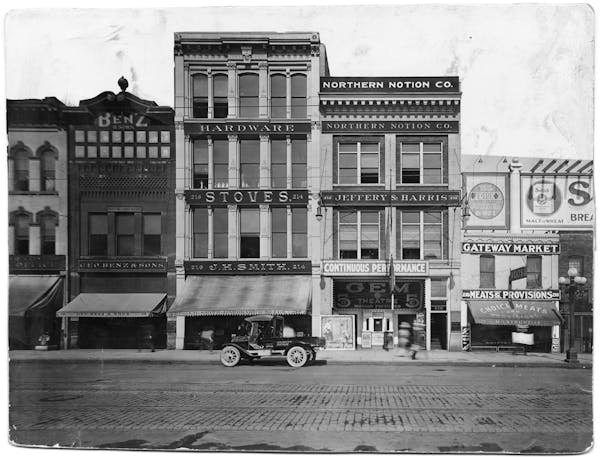In the shadow of the newly resplendent State Capitol in St. Paul stands the decidedly less glamorous Centennial Office Building.
The Centennial, so named because it was built during the 100th anniversary of Minnesota's statehood in 1958, is a dull dumpling of a building that rarely occasions much notice. Yet the Centennial and a large parking ramp to its rear occupy what was once the most intriguing ground in St. Paul: the site of a long-vanished swath of greenery known as Central Park.
The park formed the centerpiece of a small but architecturally superb residential neighborhood. It's best remembered today as the site of the first three Winter Carnival ice palaces, built in 1886, 1887 and 1888. Massive and elaborate, they were the greatest of all St. Paul's ice palaces, not to be equaled since.
The park was established in 1884 on 2.3 acres donated by three wealthy businessmen: banker William Dawson, lawyer and real estate investor Uri Lamprey and wholesaler William Lindeke.
According to historian Paul D. Nelson, who wrote a brief but excellent history of the park, all three men owned mansions just to the north. They believed a new park would help ensure high-quality residential development in the area. They were right.
By 1890 eight large houses, including five designed by renowned St. Paul architect Clarence Johnston, ringed the park, which featured an elegant central fountain, benches, gardens and other amenities.
Perhaps the finest residence on the park was a huge double house built in 1887 by George Stone for his two daughters and their husbands. Designed by Johnston and his partner, William Willcox, the double house (often referred to as the Blood-Hardenbergh House after the surnames of its original occupants) was located at the northwest corner of the park, where the Centennial Building is today.
The year 1887 also saw completion of another prominent monument in the area, Central Park Methodist Church at 12th and Minnesota streets. Featuring one of the tallest steeples in St. Paul, the church stood until 1961, when it was razed to make way for Interstate 94.
Most of the big mansions around the park were built by 1890. Later, elegant apartment buildings, including the Macey (1893) and the Mayfair (1906), filled in the remaining vacant lots.
A Capitol casualty
The park's days as a tony residential precinct didn't last long, however. And it's fair to say that the State Capitol, completed in 1905, was the prime culprit in the neighborhood's ultimate demise.
Cass Gilbert's mighty marble monument, built a block north of the park, created a huge new institutional presence in the area. Before long, other public buildings went up nearby, where the park's founding families had once lived.
The Lindeke and Dawson homes were demolished around 1910 to make way for a new Mechanic Arts High School (razed in 1976). The Lamprey residence came down five years later and was replaced by a new building for the Minnesota Historical Society (that building is now part of the Minnesota Judicial Center).
Industry also began to infiltrate the neighborhood in 1913, a time when zoning didn't yet exist in most of St. Paul. That year, the Minnesota Bread Co. completed a large bakery (razed in 1993) just to the south of the park.
By the 1920s, the area around the park was in decline. The old mansions became rooming houses, the apartment buildings were subdivided into smaller units, and the park itself took on a rather threadbare appearance. Even so, the old neighborhood, shabby but genteel, continued to perk along through the 1930s and 1940s.
Make way for the mall
After World War II, however, the park and its environs were doomed by the Capitol Approach project, which resulted in creation of the State Capitol Mall and several new state office buildings in the 1950s.
The mall is such a fixture in St. Paul today that it's hard to imagine how vast a transformation it wrought. All told, about 100 acres were cleared for the mall and its approaches, including the right of way for I-94, which was built just to the south in the 1960s.
Before the mall was built, the area immediately south of the Capitol was considered a slum, occupied by scores of old and often decrepit buildings. One newspaper went so far as to describe the neighborhood as a "screen of ugliness" blocking views of the Capitol.
The mansions around Central Park were hardly eyesores, however, and some ranked among the finest of their time in St. Paul. But they had no chance to survive once the plans for the mall were in place.
All of the homes and apartments on the west side of the park were demolished in 1956, after which the Centennial Building rose in their place. The old apartments on the park's east side survived a bit longer. The last of them fell to the wrecker in 1974, the same year the park itself was replaced by a parking ramp.
A small green space atop the ramp provides a faint reminder of the historic park, as does the name of an alley-like street — still known as Central Park Place E. — that runs behind the Freeman Office Building on Robert Street.
But aside from these traces, the park and the unique neighborhood that blossomed around it now exist only in the realm of memory.
Larry Millett is an architecture critic and author of 14 nonfiction books and eight mystery novels. He can be reached at larrymillett.com.
